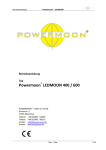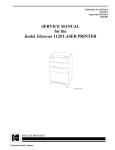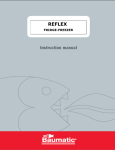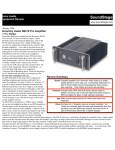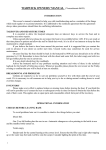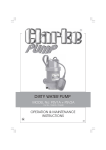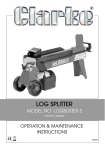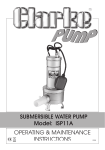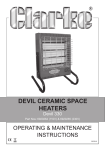Download Clarke PHT3 Specifications
Transcript
PATIO HEATER MODEL No. PHT3 Green Black Stainless OPERATING & MAINTENANCE INSTRUCTIONS 0102 Thank you for purchasing this CLARKE PATIO HEATER. WARNING! It is MOST IMPORTANT that ANYONE attempting to use this apparatus read this booklet thoroughly beforehand and carefully follow the instructions given. This will ensure their safety, and that of others around them. Additionally, you can look forward to the heater giving you long and satisfactory service. This heater is designed for OUTDOOR USE ONLY GUARANTEE This CLARKE product is guaranteed against faulty manufacture for a period of 12 months from the date of purchase. Please keep your receipt as proof of purchase. This guarantee is invalid if the product is found to have been abused or tampered with in any way, or not used for the purpose for which it was intended. Faulty goods should be returned to their place of purchase, no product can be returned to us without prior permission. This guarantee does not effect your statutory rights. SPECIFICATIONS Type of gas Propane Rated pressure 37bar Rated heating capacity 11 kW - 40,000BTU/Hr Consumption 0.900 kg/h Part No. Black 6919100 Green 6919105 Stainless Steel 6919110 2 FEATURES Patio Heaters are portable radiators, simple, highly efficient and reliable, whose functions are based on the principle of reflected heat. Wide areas can be heated depending upon atmospheric conditions. These models can be used outdoors or indoors if the room is large enough and has a constant supply of fresh air. Patio Heaters are suitable for an environment with a volume of at least 200 m3 Patio Heaters do not expel exhaust gas, non-polluting liquid gas fuel is used (Propane). This heater complies with current European directives and standards. The Heaters are fitted with the following safety devices a. THERMOELECTRIC PROTECTION: The pilot flame heats an element that, when heated, keeps the gas tap of the heater open (NOT THE ONE ON THE CYLINDER). Within one minute of the pilot flame being extinguished, the gas supply is shut off from the heater tap. C. PIEZOELECTRIC LIGHTING: Undoubtedly the safest method of lighting, i.e., no naked flame is required. 3 SAFETY PRECAUTIONS This Patio Heater is designed for OUTDOOR USE ONLY • Patio Heaters MUST NOT be used in homes, offices and similar environments. • NEVER MAKE ANY MODIFICATIONS to the heater. • Patio Heaters can be installed in rooms with a volume of AT LEAST 200 M3, PER HEATER • MAKE SURE that there is no flammable material within 2M of the heater • MAKE SURE that all other materials are more than 1M from the heater • PAY ATTENTION to whatever may be above the heater because: At 30 cm from the hood the temperature is 50°C At 60 cm from the hood the temperature is 40°C At 90 cm from the hood the temperature is 30°C • Any flammable coating must be at least 1M from the reflecting hood of the heater. • DO NOT TOUCH any part of the heater above the stack ,it could be very hot, enough to cause serious burns. • ALWAYS wait at least one hour after switching off the heater completely before touching the parts above the start button. • NEVER cover the heater . • DO NOT START the heater if it is not completely assembled. • To stabilise the heater, ALWAYS use cylinders with an empty weight of not less than 11 kg. • DO NOT USE the heater when there are strong winds, or secure its base to prevent the possibility of it tipping over. • NEVER move the heater when it is lit. • NEVER move the heater just after switching off, but wait until it is cool. • REMOVE the gas cylinder from its compartment when the heater is not in use for long periods. • DO NOT replace the rubber hose (8) with one greater than 1M in length. • ALWAYS close the gas cylinder valve after use. • ALWAYS keep a constant check on the heater when it is operating. • DO NOT KEEP gas cylinder in cellars, basements, stairwells, corridors, underground passages, etc. • DO NOT EXPOSE the gas cylinder to the sun: if this is necessary, it must be covered. • KEEP the cylinder away from sources of heat. 4 ASSEMBLY 1 2 Carefully unpack the components and lay them out, checking to ensure that no damage was suffered in transit. Should any damage be apparent, you should contact you Clarke dealer immediately. 3 Ensure the nuts on the top of the diffuser are tight. Attach the Diffuser to the Burner assembly. 4xScrews M5x10 5 4 6 5 Attach Support Brackets to Stack Support. Attach Base to the three support brackets. 6xBolts M6x20 6xBolts M6x20 12xFlat Washers 12 Flat Washers 6xLock Washers 6xLock Washers 6xM6 Nuts 6xM6 Nuts 7 Attach stack to the stack support. 3xBolts M6x12 Attach Back Cover 4x Pan Head Screws 4 Flat washers 3xFlat Washers 6 8 Lower Top Cover over Stack 9 Attach Gas Delivery Pipe to the Burner Assembly, ensuring it is perfectly tight. NOTE: USE TWO SPANNERS AS SHOWN. NOTE: Test the joint for leaks by applying a soapy liquid to the joint. If bubbles appear, tighten the nut. The joint must be gas tight. 10 11 Insert Gas Delivery Pipe into Stack Secure Burner Assembly to Stack. 3xScrews M6x12 3x Flat Washers 7 12 13 Attach Reflector by placing two flat washers on each post followed by the reflector, then the round headed nuts. Attach the regulator hose to the connection arrowed, using the worm drive clip supplied, ensuring the connection is perfectly tight. NOTE: The hose should be approx. 40cm in length. 14 Slide the front panel into place. NOTE: Check the Regulator and hose for leaks by applying a few drops of soapy liquid to the joints. If any bubbles are apparent, investigate and repair before proceeding. 8 OPERATION WARNING! Before using your Patio Heater ensure that all safety precautions have been complied with. A. Connecting the Gas Bottle Fig.1 1. Ensure the Burner Control Knob (A, Fig.1) is in the OFF position. To do this, push the knob IN and turn fully CLOCKWISE. 2. Remove the access panel and check condition of the regulator and hose. 3. Place the cylinder in its compartment. 4. Screw the regulator into the outlet port on the cylinder and tighten securely ensuring the flexible hose is not stretched or kinked. . 5. Check that the tap turns easily and that there are no gas leaks, using foam or soapy water...NEVER use an open flame. B. Lighting The Pilot Light We recommend that first time starting be carried out in the open air, as fumes are given off due to the elimination of the protective lubricants. 1. Turn ON the gas by turning the tap anticlockwise then fully secure the access panel 2. Push the Burner Control Knob IN and turn ANTI-CLOCKWISE to the PILOT position. IMPORTANT! DO NOT force the Knob. NOTE: For the initial start or whenever the gas bottle has been changed, push the Control Knob IN and hold in this position for two minutes to ensure all air has been purged from the system before proceeding. 3. Holding the knob in the ‘pushed IN’ position, press the piezo ignition button (B, Fig.1) repeatedly until the pilot light ignites. 4. Continue to hold the Control Knob ‘IN’ for a further 1 minute after the pilot light is lit. When it is released, it will pop back outwards and the pilot light should remain ‘ON’. C. Low Burner Setting With the pilot light lit, turn the Burner Control Knob anti-clockwise until it reaches the first indent. D. HIGH Burner Setting Turn the Burner Control Knob anticlockwise until it stops. NOTE: Always allow the burner to operate in the LOW position for 5 minutes or so, before turning to the High position. To turn the patio heater OFF...first push the Burner control Knob ‘IN’ and turn it fully CLOCKWISE, then, when the flame has extinguished, turn the supply OFF at the gas bottle. IMPORTANT! If the Burner fails to operate, turn the Burner Control Knob to the OFF position and wait 5 minutes before trying again. 7 STORAGE The heater is constructed from materials to withstand normal weather conditions, however, it is advised to store under cover for maximum preservation. If there are problems of space, the reflecting hood (1) can be removed, and the nuts and washers preserved with care (NB: they are all stainless steel). Remove the cylinder from its compartment. Enclose the burner unit in a polythene bag and similarly wrap the side covers to discourage the possibility of local wild life from setting up home. RESTARTING AFTER STORAGE Remove the Diffuser, by removing the four screws around the outer band, clean inside and out with an ordinary cloth (DO NOT USE oily products that would produce fumes when the heater is next switched on). Remove any cobwebs and dust from the Burner, then reassemble the parts. Check the rubber hose and if cracked or damaged in any way, replace it with a hose of approx. 40cm in length. MAINTENANCE There are no user serviceable parts for this heater. It is necessary only to keep the various components clean, particularly the underside of the hood. DO NOT clean the heater when it is lit or only just switched off. Wait until it has cooled down. Clean using a clean soft cloth. CHECK annually that the hose connecting the regulator to the Delivery pipe is in good order: otherwise, replace it. (see your Clarke dealer) Any repairs should be made by trained technicians and with original replacement parts. For parts and servicing, consult your CLARKE dealer. POINTS TO REMEMBER Propane gas is stored under pressure, and the filling process causes the cylinder to get warm. Taking gas out of the cylinder reverses this process and the cylinder gets colder. When a cylinder is stored outside, the cylinder temperature equalises with the ambient temperature. In the summer, taking cold gas from a warmish cylinder is not so much a problem, but in winter, an already cold cylinder gets even colder as gas is removed, and moisture from the warmer air condenses on the cold surface of the cylinder, similar to condensation on a window. In the worst case, this moisture may even begin to freeze on the outside of the regulator. This also has an effect on the flow rate of the gas. It should be noted that the flow rate at -10 degrees C is only half that at 15 degrees C. The volume of gas, and hence the heat output, is therefore similarly effected. 10 TROUBLE SHOOTING PROBLEM POSSIBLE CAUSE REMEDY Gas odour during setup Gas leak Check all gas connections Gas odour before first ignition Gas leak Check all gas connections When piezo igniter button is pressed, there is no spark at pilot electrode. Igniter electrode or piezo wire not connected Reconnect igniter electrode or wire** Broken electrode or piezo wire Replace broken electrode or wire** Faulty piezo igniter Replace piezo igniter** Electronic ignition is wet Keep ignition system dry Gas supply not turned on Turn on gas supply Control knob not in PILOT position Follow Operational Instructions Low gas pressure Check gas supply pressure Faulty Regulator Replace regulator Crimped pilot gas line Replace pilot gas line** Air in gas line Pressing control knob in for 1-2 minutes or until you smell gas. Thermocouple not hot enough Hold down control knob longer in pilot position. When igniter button is pressed, there is spark at the pilot electrode, but no pilot ignition Pilot lights but does not stay lit Connections not secure Tighten connections Faulty thermocouple Replace thermocouple** Faulty valve Replace valve** Windy conditions Shield from wind Delayed ignition Burner lights but does not stay lit Incorrect Burner flame Low gas pressure Check gas supply pressure Blocked orifice Check orifice opening** Faulty valve Replace valve** Low gas pressure Check gas supply pressure Connections not secure Tighten connections Faulty valve Replace valve** Faulty Regulator Replace regulator Windy conditions Shield from wind Incorrect gas supply or pressure Check gas supply pressure Blocked orifice Check orifice opening** Faulty valve Replace valve** Faulty Regulator Replace regulator High altitude Adjust orifice size for altitude** ** Consult your Clarke dealer SPARE PARTS AND SERVICE For Spare Parts and Service, please contact your nearest dealer, or CLARKE International, on one of the following numbers. PARTS & SERVICE TEL: 020 8988 7400 PARTS & SERVICE FAX: 020 8558 3622 or e-mail as follows: PARTS: [email protected] SERVICE: [email protected] 11














